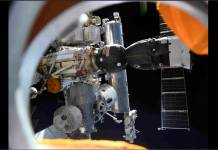
The new NASA’s vortex coronagraph, used at the W. M. Keck Observatory in Hawaii has recently imaged the new planet formed from the young star HD 141569, located about 380 light-years from Earth.
The vortex coronagraph is installed inside the Near Infrared Camera 2 (NIRC2).The images are generated due to some “masks” that redirect the bright light of the stars, to scan into closer regions where these planets are forming, according to a statement from NASA.
The images retrieved from Keck Observatory show the ring of a planet-forming dust around the young star HD 141569.
It also spotted a cool brown dwarf (which is an object that didn’t quite grow at all to start burning fuel and finally becoming a star) known at the moment as HIP 79124 B, which is orbiting the young star at a distance of about 23 times further than Earth is from the Sun.
NASA can now see planets that are near their stars
NASA officials said in a statement these stars outshined planets by a factor of a few thousand to a few billion, which make their dim light of planets tough to detect, specifically for worlds that are close to their stars.
The researchers said the removed that obstacle by redirecting the vortex coronograph light far from the camera’s sensors. To do so, they combined light waves thus canceling them out.
“The vortex coronagraph allows us to peer into the regions around stars where giant planets like Jupiter and Saturn supposedly form,” said Dimitri Mawet, who is a research scientist at NASA’s Jet Propulsion Laboratory (JPL).
In the past, they were only capable of capturing image gas giants that were born much farther out from there. However, now with the vortex, they were able to see planets that were orbiting as close to their stars as Jupiter is from our Sun, to even about two or three times closer that it was available before.
While they were studying the images from the HD 141569, the astronomers found evidence of pebble-sized grain of olivine in the planet-forming material that is surrounding the young star.
The Olivine is one of the most abundant silicates on the Earth’s mantle, and it could be an early sign of planet formation in this region, according to NASA officials.
Source: Space











